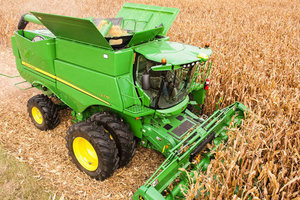Soil compaction is an issue that some grain producers are concerned about during harvest. With these concerns in mind, experts from the University of Nebraska-Lincoln Institute of Agriculture and Natural Resources are providing tips for how to avoid compaction, especially in areas where rain has left fields soft.
If combines and grain carts do not leave a rut, the experts claim that soil compaction will not be a large concern. It typically occurs when there is a loss of pore space between soil particles. If no ruts are formed, this indicates that there was enough soil structure to support the weight of the machinery. In turn, there is no need to worry about compaction.
In the event that ruts are formed, producers may want to consider tillage as an option. This can help break up compaction, but the soil must be dry.
In the event that soil was moist when the ruts formed, tillage might not be an option. Doing so can cause even more compaction, as the lubricated soil particles may be more likely to slide under the weight of equipment.
Grain harvesters may fair best by controlling the amount of traffic that passes through certain areas of their field. Up to 85 percent of soil compaction damage occurs during the first pass of tires. Using the same traffic lanes yearly can eliminate the development of newly compacted soil that may come with new lanes.
